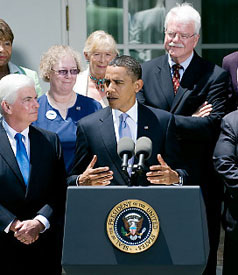
|  |  |  Editorials | Opinions | July 2009 Editorials | Opinions | July 2009  
From Tax Breaks To Tax Hits
 Sam Pizzigati - The Campaign for America's Future Sam Pizzigati - The Campaign for America's Future
go to original
July 19, 2009


| | Obama discusses health care during a briefing in the Rose Garden. (Loeb/Getty) |  |
In the struggle for a less unequal America, could the House health care surtax on the wealthy turn out to be a game-changer?

The push to overhaul the system that takes care of America’s health may be on the verge of morphing into something even grander, a promising new offensive against the unhealthy concentration of America’s wealth.

The entire House Democratic leadership now stands united behind health care reform legislation that hikes taxes on America’s richest well beyond the levels that pundits, over recent years, have deemed “politically feasible.”

At the heart of that legislation: a 5.4 percent surtax on income over $1 million.

Taxpayers who make over $1 million, under the bill now moving through House committees, would pay $88,582 more to Uncle Sam in 2011, the year the bill would kick in. Taxpayers who make over $2.4 million — America’s most affluent 0.1 percent — would see their tax bills go up by an average $280,000.

Overall, if the House surtax ever became law, 2011 would likely see the largest single-year tax hike on America’s rich since 1935.

That’s because the George W. Bush tax cuts enacted in 2001 and 2003 — a bonanza for the awesomely affluent — all expire at the end of 2010. President Obama has pledged repeatedly that he won’t let any of these tax cuts for the rich be extended.

If the President sticks to that promise, the tax rate on income in the nation’s top income bracket — currently 35 percent — would revert back to 39.6 percent, the rate in effect when Bill Clinton left the White House. The House health care surtax would bring that top rate, on income over $1 million, to 45 percent.

The United States hasn’t seen a tax rate on the rich that high since 1986.

The health reform surtax would actually take a bigger bite out of rich people’s income than these numbers suggest, Citizens for Tax Justice points out, for two reasons. The first: The surtax would apply to “adjusted gross income,” the IRS label for income before taxpayers subtract deductions and exemptions.

Rich people do far more subtracting than average taxpayers. They’ve lobbied hard, over the years, to fill the tax code with loopholes, and they aggressively exploit these loopholes to lower their “taxable” income.

Rich people, under the House health care reform, wouldn’t be able to do this exploiting on the surtax. They would have to pay surtax on what they actually make.

And none of the income the rich make, in the House surtax plan, would get preferential tax treatment. Under current law, income from dividends and capital gains gets preference aplenty. The dollars the rich pocket buying and selling assets only face a 15 percent tax.

This preferential rate adds up to an enormous tax break for America’s wealthiest. Taxpayers making over $10 million, according to the most recent IRS stats, take in just under 60 percent of their income from tax-advantaged capital gains and dividends.

What’s this tax break mean for the richest of the rich? In 2006, the nation’s top 400 taxpayers averaged $263.3 million in income. They paid, thanks largely to preferential treatment for capital gains, only 17.2 percent of that income in federal tax.

These rich would get no such break on the surtax. The 5.4 percent surtax would apply equally to all income over $1 million, capital gains and dividends included.

Over a decade’s time, the congressional Joint Tax Committee estimates, the House health care reform surtax would raise $540 million from wealthy Americans, over half the cost of ensuring all Americans affordable health care insurance.

The surtax would start at $350,000 for couples filing jointly. Incomes between that level and $500,000 would be subject to a 1 percent tax. The charge would rise to 1.5 percent on incomes between $500,000 and $1 million.

In the end, a mere 1.2 percent of the nation’s households would pay any surtax whatsoever under the House Democratic plan. For many of these households, the surtax would be modest. Families making $500,000, for instance, would pay $1,500 in surtax, just 0.3 percent of their total annual income.

These families would, in fact, likely come out financially ahead if the House health care reform became law. They would pay modestly more in tax, but they would also probably pay less for health care insurance premiums — maybe much less — after the reforms in the House bill start impacting the health care system.

But even far wealthier families ought to count themselves fortunate. In 2011, if the House health care reform legislation became law, they’d face at most a 45 percent top federal income tax rate. Fifty years ago, under Republican President Dwight D. Eisenhower, America’s richest faced a top tax rate at 91 percent.

Sam Pizzigati edits Too Much, the online weekly on excess and inequality. |

 |
|  |



